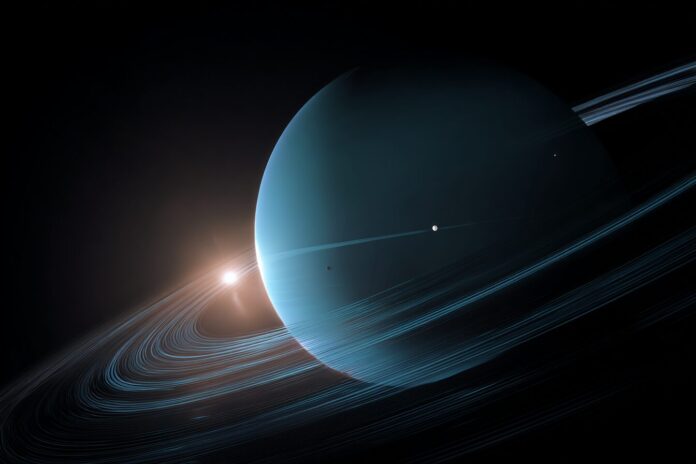NASA’s James Webb Space Telescope (JWST) is once again rewriting the chapters of astronomical discovery. Its recent unveiling of a previously unknown moon orbiting Uranus underlines not only its advanced technological prowess but also the vast mysteries that continue to shroud our solar system. Most importantly, this discovery deepens our insight into Uranus’s complex system, encouraging scientists to re-examine the formation and evolution of planetary satellites.
Because even familiar planets hold secrets, the identification of this tiny moon reveals that there is much more to learn about the outer solar system. Therefore, the discovery imparts significant implications for our understanding of satellite dynamics and the historical processes that have sculpted the Uranian environment.
A Brief Overview: Uranus’s Expanding Moon Family
Historically, Uranus has been known to have 28 confirmed moons, each contributing uniquely to the planet’s dynamic system. Voyager 2’s flyby in 1986 and subsequent ground-based surveys have provided a broad perspective on the larger, more visible moons. Because there were noticeable gaps in our knowledge, many astronomers suspected that faint, smaller moons could have been simply hidden from view.
Besides that, advanced instruments like JWST now make it possible to probe these previously inaccessible regions. With its cutting-edge imaging technology, scientists can capture detailed views of even the most elusive satellites, reaffirming that the history of Uranus is still a story unfolding before our eyes.
Meet S/2025 U1: A Tiny, Elusive Satellite
The newly detected moon, provisionally designated S/2025 U1, is exceptionally small, measuring merely 6 miles (10 kilometers) across. Because it is significantly less massive than Uranus’s larger moons such as Titania or Oberon, it has eluded detection until now. Most importantly, JWST’s near-infrared vision was instrumental in its discovery, emphasizing the observatory’s capability to seek out minute astronomical objects.
In addition, S/2025 U1 orbits approximately 35,000 miles (56,000 km) from Uranus’s center. This close proximity, combined with its tight and nearly circular orbit, suggests that the moon likely formed in situ. Therefore, its presence adds a new perspective on satellite formation theories, as well as the dynamical evolution of Uranus’s interior satellite system. Researchers at institutions such as SETI and Astronomy.com have highlighted the significance of this diminutive satellite in reshaping our models of planetary system development.
How JWST Revealed the Hidden World
The detection of such a small, faint body was made possible by JWST’s exceptional Near-Infrared Camera (NIRCam). During a dedicated observation session on February 2, 2025, scientists executed a series of 10 exposures, each lasting 40 minutes. Because these exposures were carefully stacked and analyzed, subtle yet significant light glints indicated the presence of S/2025 U1.
Most importantly, the utilization of advanced image-processing techniques allowed researchers to isolate the faint signals from background noise and glare from Uranus itself. Therefore, this breakthrough not only emphasizes JWST’s technical advantages over ground-based observatories but also serves as a testament to the evolving methods in modern astronomy. For more details, read about the discovery on the Space.com website.
Implications for Planetary Science and Future Discoveries
Because S/2025 U1 is both minute and faint compared to other satellites, its discovery raises compelling questions about what other hidden bodies might exist around Uranus. Most importantly, researchers believe that if such a small moon can go undetected for so long, many more may lie hidden within the shadows of this giant planet’s complex system. Consequently, further exploration could unveil a multitude of new moons, each adding depth to our understanding of planetary formation and satellite evolution.
Besides that, the finding has broader implications for planetary science. It encourages the reassessment of theories about moon formation, particularly in dynamic environments where gravitational interactions between satellites and rings intermingle. Additionally, as discussed on SETI Institute’s news site, the discovery underscores how technological advances are sparking new debates and methodologies in astronomy.
Why This Discovery Matters
Most importantly, the announcement of S/2025 U1 is a landmark achievement in modern astronomy. It signifies the beginning of a new era where advanced instruments allow us to delve deeper into the hidden corners of our solar system. Because of innovations in infrared imaging, we are now able to detect objects that were once considered too elusive to be seen.
Moreover, this discovery is a clear reminder that progress in science is continuous. Therefore, while the legacy of Voyager 2 still informs much of our understanding, JWST is rapidly complementing and expanding upon that knowledge. As highlighted by LiveScience, the ongoing exploration of outer planets is set to revolutionize our interpretations of planetary dynamics and evolution.
What’s Next? Naming and Further Research
Currently, S/2025 U1 is designated only as a provisional name. The International Astronomical Union, a guardian of astronomical nomenclature, will eventually assign an official name. Because the tradition often honors mythological figures or literary characters—as seen with many of Uranus’s other moons—it is anticipated that the final name will carry historical or cultural significance.
Besides that, the discovery fuels plans for further research. Astronomers are gearing up to utilize JWST, along with next-generation ground- and space-based observatories, to search for additional, yet-to-be-discovered satellites around Uranus and other outer planets. Therefore, each new finding will not only fill gaps in planetary catalogs but also refine our understanding of the dynamic forces that shape planetary systems across the cosmos. For more insights, visit ESA Webb.
Conclusion: A New Frontier for Discovery
In summary, the detection of S/2025 U1 marks a significant stride in astronomical research. Because this discovery was possible through the combined power of advanced technology and methodical observation, it opens the door to a deeper exploration of Uranus’s many mysteries.
Therefore, as we continue to reach further into the unknown, we are reminded that our solar system is a dynamic and complex universe of exploration. Every new observation has the potential to reshape our scientific narratives and inspire future generations to look upward with wonder.



